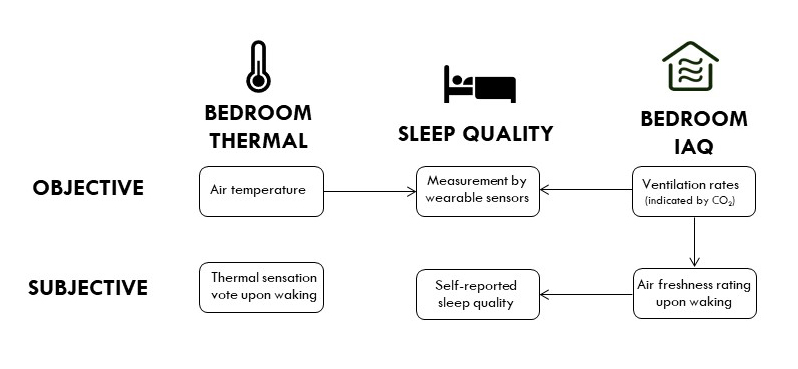How Bedroom Temperature, Ventilation Affect Sleep Quality
From ASHRAE Journal Newsletter, September 14, 2021
The microclimate that your bedding creates affects your sleep comfort more than your bedroom’s temperature does, according to a recent Science and Technology for the Built Environment article.
“Associations of Bedroom Temperature and Ventilation with Sleep Quality” studied the effect of bedroom environmental quality on the quality of sleep in a field study conducted in Sydney, Australia. Researcher Richard de Dear, Ph.D., discussed the study with ASHRAE Journal.
How does this research differ from other research about bedroom temperature and sleep?
The overwhelming majority of earlier research on this topic has been conducted in the artificial laboratory setting, which, at best, can only approximate real bedroom environmental conditions and the experience of those conditions by “real” subjects, as opposed to most laboratory studies in this field using university student subjects. Those rare sleep studies conducted outside the lab setting were in a very specific building typology: student dorms.
The Sydney research project described here is one of the few surveys conducted in normal residences with non-student subjects. This was one of the rare studies to draw causal linkages between bedroom environmental conditions and sleep quality of non-student subjects. In this sense, our naturalistic (conducting surveys in normal residences, with non-student subjects) research design makes the findings more generalizable to the population at large.
Why is it important to explore this topic now?
We spend one-third of our lives sleeping, and sleep is demonstrably important to our health and well-being. Poor quality of the sleeping environment is a primary source of sleep disturbance, yet bedroom indoor environmental quality (IEQ) remains under-researched.
In most countries, there are no standards or official guidelines specifically for bedroom IEQ. As a result, the default assumption has always been that optimal sleeping environments are the same as waking environments. Sleeping persons have distinctive thermal requirements because of, among other things, lowered metabolic heat compared with people who are awake. HVAC systems and their controls can be improved with more such research into thermal comfort and ventilation in bedrooms.
How can this research further the industry's knowledge on this topic?
We think the main implication of this study into the operation of sleeping environments is that bedroom ventilation should be prioritized over thermal environmental conditions.
Why? First, because IAQ seems to have a more direct impact on both subjective and objective metrics of sleep quality. Second, because we can easily adapt the sleeping microclimate underneath bedding where it counts most by tuning its insulation properties to suit a range of bedroom temperatures.
What lessons, facts and/or guidance can an engineer working in the field take away from this research?
Retrospective estimates of nocturnal thermal comfort (i.e., morning-after perceptions) seem to be unrelated to objective bedroom thermal conditions during sleep. ASHRAE defines thermal comfort as “that state of mind that expresses satisfaction with the thermal environment,” but sleeping persons are oblivious to that state of mind—at least within the moderate range of bedroom thermal environments. This may partly be because we sleep in a distinct microclimate underneath bedclothes, not in the actual room environment per se.
Bedroom air quality tells a different story; a simple, objective measurement of bedroom air quality (namely CO2 concentration) deteriorates throughout the course of our sleep, particularly in rooms having minimal air-change rates. Upon waking, our subjective impression of the air quality, or “air freshness,” during our sleep is dominated by our immediate perceptions upon waking, when objective conditions are likely to be their worst. While that immediate air quality impression upon waking may differ from the average air quality of the bedroom throughout the sleep period, it is still correlated. Our subjective perceptions of “air freshness” are statistically associated with objective ventilation rate (CO2).
So, what is the connection between bedroom environmental quality (thermal and IAQ) and sleep quality? First, we found that objective thermal conditions in the bedroom were associated with objective sleep quality metrics (i.e., measurement by wearable sleep-trackers), whereas subjective thermal comfort assessments were not. However, objective IAQ (CO2) in the bedroom was associated with objective sleep quality metrics, as was subjective IAQ (“air freshness”) with subjective sleep quality ratings.
We’ve summarized these connections between objective and subjective dimensions of bedroom IEQ and sleep in the following schematic:

Were there any surprises or unforeseen challenges for you when preparing this research?
Recruiting participants for this study was more difficult than we expected, mainly because of suspicions about the indoor environmental quality monitoring equipment we proposed installing in their bedroom. Some thought our IEQ monitor was going to intrude on their privacy in the bedroom. Thankfully, most participants could be persuaded to relax their concerns about bedroom privacy when we explained the rigor and vigilance of the University of Sydney’s Human Research Ethics Committee’s oversight of this project.
What additional research is needed as a result of this study?
The bedroom study was conducted in the late summer and early autumn of Sydney, Australia’s relatively mild climate, so we missed out on the seasonal extremes of summer and winter. If we were to take this study further, we would extend the seasonal coverage of Sydney’s climate and maybe extend the study to other, less “comfortable” climate zones.
Second, the findings of this study confirm the idea that bedroom temperature is less relevant to the thermal comfort of the sleeper than the bedding microclimate of the sleeper (the air surrounding the body under the bed cover). Bedding materials should be adaptive to the bedroom’s indoor climate. We think it would be valuable to direct future study toward the relationship between these two scales of environment in the bedroom and the quantitative effects of bedding insulation mediating the relationship between them.